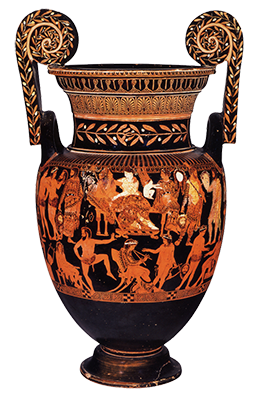The time is the early 420s BCE, the place, the Theater of Dionysus on the slopes of the Acropolis at Athens. The crowd eagerly awaits the start of a brand-new play by the renowned playwright Sophocles: his Oidipous turannos, or Oedipus the King.

BUT WHAT, EXACTLY, is it that this audience has come to see — what exactly was ancient tragedy? What would the experience of watching this or another drama have been for our audience? What effect would the political, cultural, and social context have had on the way they viewed the play and reacted to it? And how do we today react to the drama of the ancient Greeks? What meaning does it have for our lives? Is the suffering ancient tragedy depicts wholly foreign to modern sensibilities? Or shall we moderns find therein something to identify with?
IN THIS COURSE, students will consider those and similar questions. For by studying the tragic drama of ancient Greece and Rome in English translation, and by comparing it to select instances of ancient comedy and modern drama, they shall deepen their understanding of an art form that boldly explored human existence at the extremes.
Pronomos Vase

This vase, from which comes the scene at top, was created at Athens and dates to around 400 BCE. It is called the "Pronomos Vase" because, among the depicted figures, identified by label, is that of Pronomos, an aulētēs, or player of the auloi, the ancient Greek double pipes. Also depicted and named are Dionysus, divine patron of theater; Dionysus' consort, Ariadne; the playwright Demetrios; the khorēgos (producer) Kharinos; and the entire cast of a satyr play. (Satyr plays came fourth in the tragic tetralogy; they were were like funny tragedies — more on the Terms page.) The vase was found in 1835, in a tomb in the southern Italian town of Ruvo di Puglia. It currently forms part of the collection of the National Archaeological Museum of Naples. It was removed from display after the earthquake of 1980.
Why is the Pronomos vase important? Whether or not it commemorates an actual production of an actual play (a disputed point), it still gives us a sense of classical Athenian theatrical performance as something real and appreciated. It establishes strong connections between theater and its patron, Dionysus, for the god is depicted twice: once on one side with actors and other humans involved in a production; once on the other side with the usual mythic retinue of satyrs and maenads. Its find site, in the territory of the non-Greek Iapygians, in southern Italy, also matters. Whether or not the non-Greek-speaking Iapygians would have known much about Athenian drama, a vase like this, whose painting may be a copy of a commemorative plaque at Athens, suggests that Greek-Athenian theater carried cultural cachet in the wider Mediterranean world.
Learn more about the vase at the Beazley web site and at the Bryn Mawr Classical Review.
